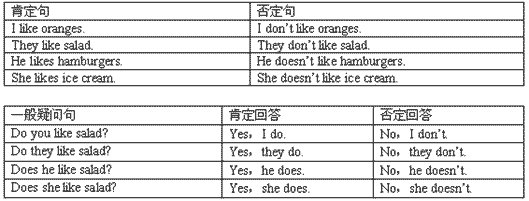改错。( ) 1. The noise was too loud that we were hardly able to hear ourselves talk. A BC ( ) 2. He will call you as soon as he arrive.A B C ( ) 3. Last tim-九年级英语
而且,句子中有了助动词,谓语动词就不需要有任何变化了,即用动词原形表示。例:
We have six classes every day. 我们每天上六节课。
I often get up at 6:30. 我经常6:30起床。
Jack likes Chinese food very much.杰克很喜欢中国饮食。
We can see some pictures on the wall. 我们能看到墙上的画。
4.一般现在时常用的时间词语
常用于一般现在时的词语有 sometimes/usually/often/every day(week,year)/ now/always 等。
这些时间词语只是辅助作用,这些词语也可用于其它的时态,所以谓语动词变化才是最关键的。
注意:当表现强烈的感情色彩时,尽管有如 always/never/seldom 等频率副词,但一般在频率副词前加上be动词,后面变为动词的现在分词形式。
例:My father lose his key again. He is always losing his key.

一般现在时中当主语为第三人称单数的时,动词上要改为第三人称单数形式。
考点名称:过去将来时
- 过去将来时:
表示从过去的某一时间来看将来要发生的动作或存在的状态。过去将来时常用于宾语从句和间接引语中。
去将来时的出发点是过去,即从过去某一时刻看以后要发生的动作或状态。 过去将来时表达法:
1. would+动词原形
例如:When you asked Li Lei for help, he would never refuse you.
2. was/were going to+动词原形
例如:He told ustaht he was going to attend the meeting.
3. was/were to+动词原形
例如:Li Lei was to arrive soon.
4. was/were about to+动词原形
例如:We were about to leave there when it began to rain heavily and suddenly.
5. was/were+现在分词
例如:He was leaving the next day.句型结构:
肯定句:主语+be(was,were)going to+动词原形~.
否定句:主语+be(was,were)not going to+动词原形~.
疑问句:Be(Was,Were)+主语+going to+动词原形~?
肯定句:主语+would(should)+动词原形~.
否定句:主语+would(should)not+动词原形~.
疑问句:Would(Should)+主语+动词原形~?
过去将来时的构成和一般将来时一样,只不过把助动词be变为过去式,把will,shall变为过去式。
例句:I didn''t know if he would come. =I didn''t know if he was going to come. 我不知道他是否会来。过去将来时具体用法:
一、would+不定式
1.用“would+不定式”表示过去将来时间通常带有表示过去将来的时间状语,而且多见于从属分句。
He said he would come back the next day.
2.如果要表示在过去将来某一时间正在进行得动作,可用“would+不定式进行体”。
例如:He never imagined that some day he would be living away from his motherland.
这种“would+不定式进行体”结构也可能仅仅表示一般过去过去将来时间,如同“will/shall+不定式进行体”表示一般将来时间一样。、
例如:He told me that Mary would be coming the next day.
如果要表示在过去将来某时以前业已发生得事态,可用“would+不定式完成体”。
例如:The delegation would have arrived by four o'clock that afternoon.
如果要表示从过去某时开始一直延续到过去将来某时得动作或事态,可用“would+不定式完成进行体”。
例如: She said that by the end of May she would have been studying medicine for three years
二、was/were going to +不定式
用做表示过去将来,也通常带有表示过去将来时间得状语。
例如: He said that he was going to live in the country when he retired.
用做表示的动作或事态,也可以是没有实现的意图。
例如:Last Sunday we were going to go for a picnic but it rained .
三、was/were to +不定式
用做表示过去将来,通常指按过去的计划安排将在某个过去将来时间发生得事态。
例如:They were not to get away with it if they continued to violate the law.
用作表示过去将来的安排,如果这个安排后来被取消了,没有实现,则用“was/were to +不定式完成体”表示,并可与表示现在、过去或将来得时间状语连用。 此外,其也可用作于表示以后不可避免得要发生得事件。
例如:They said goodbye,little knowing they were never to meet again.
四、was/were about to +不定式
用半助动词be about to 的过去时形式也可使其表示过去将来。这种结构通常指最近的过去将来事态,而且在一定语境中通常指未曾实现的意图:
例如:We were about to start when it began to rain .五、某些动词的过去进行时可表示过去将来时
come,go,leave,arrive,start等严格按照时间表发生的表起止的动词可用过去进行时代替过去将来时。
例1:He said the train was leaving at six the next morning.他说火车第二天早晨出发。
例2:She told me she was coming to see me.她告诉我她要来看我。六、特定场合的一般过去时可表示过去将来时
条件状语从句和时间状语从句中须用一般过去时代替过去将来时。
例1:I didn't know when she would come, but when she came I would let you know.我不知道她什么时候来,但她来了我会告诉你。
析:第一个when引导宾语从句,可使用将来时,第二个when引导时间状语从句,只能用一般过去时代替过去将来时。
例2:I didn't know if she would come,but if she came I would let you know.我不知道她是否来,但如果她来我会告诉你。
析:第一个if引导宾语从句,可使用将来时,第二个if引导条件状语从句,只能用一般过去时代替过去将来时。
考点名称:介词短语
- 介词短语:
介词是一种用来表示词与词, 词与句之间的关系的词。在句中不能单独作句子成分。
介词后面一般有名词代词或相当于名词的其他词类,短语或从句作它的宾语。介词与它的宾语构成介词词组,在句中作状语,表语,补语,定语或介词宾语。例如:at ,in, on, to
介词短语在句中可以作状语,定语,表语,补足语等。
1. 作表语
例如:It was in 2005 in Beijing.
2. 作宾语补足语
例如:He found his dog outside the station.
3. 作后置定语
例如:I even store them in boxes under my bed.
4. 作状语
例如:You are supposed to put your bread on your plate. - 常见介词用法:
1)at,in,on在……范围
at (1)表示在小地方; (2)表示“在……附近,旁边”
in (1)表示 在大地方; (2)表示“在…范围之内”。
on 表示毗邻,接壤
to 表示在……范围外,不强调是否接壤
He arrived at the station at ten.
He is sitting at the desk.
He arrived in Shanghai yesterday.
Jiangsu lies in the east of China.
Russia live on the north of China.
Fujian is to the south of Jiangsu Province.
2)above, over, on 在……上
above 指在……上方,不强调是否垂直,与 below相对;
over指垂直的上方,与under相对,但over与物体有一定的空间,不直接接触。
on表示某物体上面并与之接触。
The bird is flying above my head.
There is a bridge over the river.
He put his watch on the desk.
3)below, under 在……下面
under表示在…正下方
below表示在……下,不一定在正下方
There is a cat under the table.
Please write your name below the line. 介词短语组织形式及实例:
一、介词+名词形式
第一组
by accident 偶然
on account of 因为,由于
in addition 另外
in addition to 除 …… 之外
in the air 在流行中,在传播中
on (the/an) average 平均,一般来说
on the basis of 根据,在 …… 的基础上
at (the) best 充其量,至多
for the better 好转,改善
on board 在船 ( 车、飞机 ) 上
out of breath 喘不过气来
on business 因公,因事
in any case 无论如何,总之
in case of 假使,万一
in case 假如,以防 ( 万一 ) 免得
in no case 决不
第二组
by chance 偶然,碰巧
in charge (of) 负责,主管
(a) round the clock 昼夜不停地
in common 共用,共有,共同
in conclusion 最后,总之
on condition that 在 …… 条件下
in confidence 信任
in connection with/to 关于
in consequence 因此,结果
in consequence of 由于 …… 的缘故
- 最新内容
- 相关内容
- 网友推荐
- 图文推荐
| [家长教育] 孩子为什么会和父母感情疏离? (2019-07-14) |
| [教师分享] 给远方姐姐的一封信 (2018-11-07) |
| [教师分享] 伸缩门 (2018-11-07) |
| [教师分享] 回家乡 (2018-11-07) |
| [教师分享] 是风味也是人间 (2018-11-07) |
| [教师分享] 一句格言的启示 (2018-11-07) |
| [教师分享] 无规矩不成方圆 (2018-11-07) |
| [教师分享] 第十届全国教育名家论坛有感(二) (2018-11-07) |
| [教师分享] 贪玩的小狗 (2018-11-07) |
| [教师分享] 未命名文章 (2018-11-07) |


!["I'm going to Hang Zhou for a holiday this weekend." "______, you are there, can you buy me some green tea?"[ ]A. Because B. If C. While D. After-九年级英语](http://www.00-edu.com/d/file/ks/4/2/congshulianci/2020-02-29/small23eb042528d06b8fd98a85fdda567f9a1582930797.png)
![Tom knew nothing about it his sister told him. [ ]A. since B. if C. until D. unless -九年级英语](http://www.00-edu.com/d/file/ks/4/2/congshulianci/2020-02-29/smallfb211cbe9b333ff3fcd6e4267895f8dd1582927140.png)
![I hope to go to France some day ____there are many famous art museums.[ ]A. whenB. ifC. becauseD. whose-八年级英语](http://www.00-edu.com/d/file/ks/4/2/congshulianci/2020-02-29/smallee9baa745689a5bfa8e2346213abaf431582929348.png)
![—Oh, no. Our school football team lose again.—They won't win _____ they practice more.[ ]A. if B. unlessC. whenD. because-八年级英语](http://www.00-edu.com/d/file/ks/4/2/congshulianci/2020-02-29/small37ca5d6d6d8cd7184590f2768aec68b51582929338.png)
